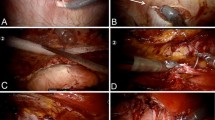Abstract
Background: One criticism of laparoscopic ventral hernia repair (LVH) is that the rectus muscles are not re-approximated to the midline, and the effect of LVH repair on the fascial edges is unclear. Progressive migration of the fascial edges toward the midline has been observed anecdotally, but objective evidence remains limited. The purpose of this study is to observe the effect of LVH repair on the rectus abdominus fascia. Methods: Patients undergoing LVH repair with defects >10 cm in horizontal diameter were identified prospectively and enrolled. All were repaired laparoscopically with intraperitoneal placement of mesh (DualMesh, W.L. Gore and Associates) using a standard approach. Radio-opaque clips were placed at the fascial edges intraoperatively to mark the defect, and plain abdominal films were taken postoperatively (Time 1) to establish the initial distance between clips (measured in cm). A subsequent follow-up film was taken (Time 2), and the difference in clip distance per patient was recorded. Results were analyzed using a chi-squared test. Results: Twelve patients qualified for analysis and their results were compared. Mean fascial defect size was 15.1 cm (range 8.3–22.0). With respect to change in clip distance from Times 1 to 2, three events were observed: (1) Diminished (i.e. medialized), (2) Enlarged, or (3) No Change. Ten patients (83%) medialized, one patient enlarged, and one patient showed no change (χ2 (d.f.=2) 9.17, p<0.0023). Conclusions: Medialization of the rectus abdominus fascia occurs in the majority of patients undergoing LVH repair. Causes for this phenomenon are unclear: however eliminating intrabdominal pressure with intraperitoneal mesh placement likely plays a role.


Similar content being viewed by others
References
Mudge M, Hughes L (1985) Incisional Hernia: a 10-year proscpective study of incidence and attitudes. Br J Surg 72:70–71
Read R, Yoder G (1989) Recent trends in the management of incisional herniation. Arch Surg 124:485–488
Stoppa R (1989) The treatment of complicated groin and incisional hernias. World J Surg 13:545–554
van der Linden F, van Vroonhoven T (1988) Long-term results after surgical correction of incisional hernia. Neth J Surg 40:127–129
Hesselink V, Luijendijk R, de Wilt J, Heider R et al (1993) An evaluation of risk factors in incisional hernia recurrence. Surg Gynecol Obstet 176:228–234
Leber G, Garb J, Alexander A, WP R (1998) Long-term complications associated with prosthetic repair of massive incisional hernias. Arch Surg 133:378–382
White T, Santos M, Thompson J (1998) Factors affecting wound complications in repair of ventral hernias. Am Surg 64:275–280
LeBlanc K, Booth W (1992) Laparoscopic repair of incisional abdominal hernias using expanded polytetraflouroethyhlene: preliminary findings. Surg Laparosc Endosc 3(1):39–41
Heniford B, Ramshaw B (2000) Laparoscopic ventral hernia repair. A report of 100 consecutive cases. Surg Endosc 14:419–423
Ramshaw B, Esartia P, Schwab J, Mason E et al (1999) Comparison of laparoscopic and open ventral herniorraphy. Am Surg 65:827–832
Heniford B, Park A, Ramshaw B, Voeller G (2003) Laparoscopic repair of ventral hernias: nine years’ experience with 850 consecutive hernias. Ann Surg 238(3):391–398
Heniford B, Park A, Ramshaw B, Voeller G (2000) Laparoscopic ventral and incisional hernia repair in 407 patients. J Am Coll Surg 190(6):645–650
Lejour M, Dome M (1991) Abdominal wall function after rectus abdominus transfer. Plast Reconstr Surg 87(6):1054–1068
Acknowledgements
The funds for this research were made possible by a generous grant from Gore Industries (Flagstaff, Arizona, USA).
Author information
Authors and Affiliations
Corresponding author
Rights and permissions
About this article
Cite this article
Sickle, K.R.V., Baghai, M., Mattar, S.G. et al. What happens to the rectus abdominus fascia after laparoscopic ventral hernia repair?. Hernia 9, 358–362 (2005). https://doi.org/10.1007/s10029-005-0018-6
Received:
Accepted:
Published:
Issue Date:
DOI: https://doi.org/10.1007/s10029-005-0018-6




